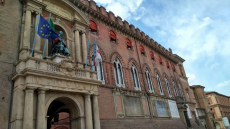
After our journey from Venice to Bologna through the pretty Italian countryside, it’s time to see what this town is all about. Bologna is famous for many things – its university and architecture, to name just two. However, we in the UK will probably know it for its namesake dish, spaghetti Bolognese. But before you get all excited about that, let me burst your bubble – you won’t find spaghetti Bolognese anywhere on the menu in Bologna. Instead, you can get tagliatelle ragu, which is the real traditional dish of the region. The only real difference (other than the name, of course) is the shape of the pasta, which comes in long, wide strips and not thin tubes. Whatever – still tastes good!
Bologna is also home to the oldest university in the world, which was founded in 1088. These days, there isn’t much to see of the original university, because over the years many of the buildings have been replaced. But that doesn’t mean to say it’s not an important place of learning and culture – it just doesn’t attract the same amount of tourists that Oxford and Cambridge do. Still, it’s only a short walk from the town centre, so it might just be worth going to see what students in the area do in their free time.
Bologna is a small city, so you can walk to everything in the town centre. The town’s main square is called Piazza Maggiore, which helpfully provides fast and free Wi-Fi to everyone within it. As we didn’t have Wi-Fi where we were staying, naturally we spent a lot of time here. Another charming little piazza that’s worth visiting is the Santo Stefano, or “Sette Chiese” because it has seven churches in it! Bologna is a unique place because of the porticos, which are basically pavements with arches on them. You’ll learn about these, and lots more about Bologna’s medieval history, if you go to the city museum. Be warned though – it’s very big!
Another thing that’s unique to architecture in Bologna are the big, red brick towers that dominate the city centre. There used to be lots more of these, but modern building work meant most of them were destroyed. They were built by the richest families in the area, to show off their wealth and power. Again, if you visit the museum, you’ll hear about them. See the picture of Bologna in the Middle Ages – it actually resembles a strange, futuristic city.
Now, this informative museum is housed in a 15th century palace in the middle of town called Palazzo Galvani. The ticket price was about 5 Euros for students, and we really learnt a lot about the history of Bologna for such a small price! Also a bonus was the inside of the palace, which had a number of beautifully decorated rooms. It reminded me of a French chateau, which is appropriate as the Café de Paris was just across the road.
We were very lucky to be in Bologna during the summer Film Festival. The town square becomes a massive outdoor cinema, and can seat hundreds of people. When we were there, it was showing the Grand Budapest Hotel, and it looked like the whole town had turned up – there were even people standing up around the edges and sitting down on the steps of the church. We had to get there an hour early to get seats! However, it was well worth the wait, and it was also free! We couldn’t believe our luck. What a fantastic idea – a way of bringing the town together, and a means of attracting tourists to the area to spend money in local gelaterias, shops and restaurants.
So, the moral of the story: if you’re in Emiglia-Romagna, you’d be stupid not to stop in Bologna, the beating heart of central Italy.
Image credit: Alice Barnes-Brown

0 Comment:
Be the first one to comment on this article.